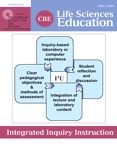Back to the Evolutionary Future
INTRODUCTION
Many books on evolution focus on the distant past or the present. Very few authors addressing a lay audience present what evolutionary changes may look like in the future. Coker has done so in this popular science book intended for a general audience. Basing the text on his similarly named course given at Elon University, the author provides a fascinating account of diverse aspects of evolution and where evolution might be heading in future generations. The book is divided into five sections and fifteen chapters. Each chapter focuses on a specific vignette. For instance, part III is called “Cellular Change,” and its constituent chapters are called: “Size Matters,” “When Evolution Turns Deadly,” “Growing a New You,” and “Clones Clones Clones.” The book offers the advantage that it can be read in any particular order, lending itself to assignment as a supplementary paperback for an introductory biology course.

EVOLUTION DU JOUR
The first chapter of the book, “From Jaguars to Avatars,” begins with premise of how we are “reinventing life” in movies, our popular culture, and in everyday life. The big picture of evolution is discussed early in the book (pp. 14–16). The reader is introduced to what the author refers to as evolution's “three core requirements”: diversity, selection process, and reproduction. Following this, the author discusses 10 lines of evidence for evolution in just six pages (pp. 16–22), and does so a lot more effectively than in most textbooks. The decline of biodiversity is the main subject of chapter 4 (“Forgotten Worlds”), which discusses the topic in both historical and local terms to make the reader aware of the role of sustainability in supporting biodiversity. Part IV, “Genetic Change,” brings the molecular aspects of evolution into the picture. Each chapter is carefully crafted to provide the reader a logical context for genetics, genetic engineering, and cloning. Coker makes an impressive case, discussing mutations in chapter 10 (“We Are All Mutants”), in what I consider one of the strongest chapters in the book. For example, the effects of mutations are described within two categories: individual and homeotic gene levels (pp. 130–131). In just a couple of paragraphs, the author describes such important concepts in a clear and concise manner.
REINVENTING LIFE
Part IV (“Reinventing Life”) includes three chapters—“The Dawn of Virtual Beings,” “Cosmic Evolution,” and “The Clearing Fog”—that deal with such topics as replacing human body parts with machine parts, spreading life across our galaxy, and adjusting to radical changes in the evolutionary process. These chapters bring the author's premise to the forefront, and some traditional scientists may frown upon Coker's ideas, such as altering other worlds to fit Earth's biology and vice versa (pp. 186–191), given the lack of concrete evidence on the subject. I found those ideas interesting, nonetheless, and they could elicit exciting class discussions among students interested in the future of biology and life outside our planet.
CONCLUDING REMARKS
This book is an interesting addition to popular science dealing with evolutionary biology and is an engaging and easy read for undergraduates not majoring in biology. Its value lies in the simplicity of its language and a potpourri of exciting ideas that could lead to productive class discussions. Instructors using the book need to make students aware that most views presented here are the author's own and are subject to dispute by the evolutionary biology community. Nevertheless, I enjoyed reading a book that takes such a nontraditional and captivating approach to evolution and where it can lead in the near or distant future.



